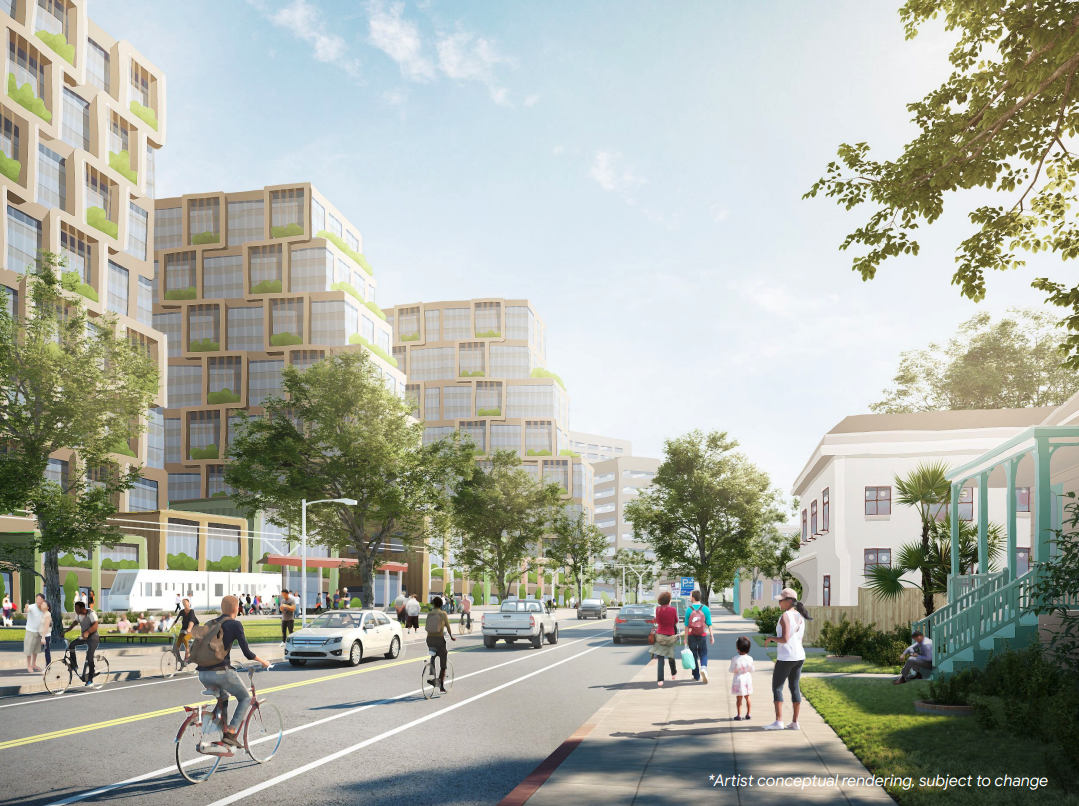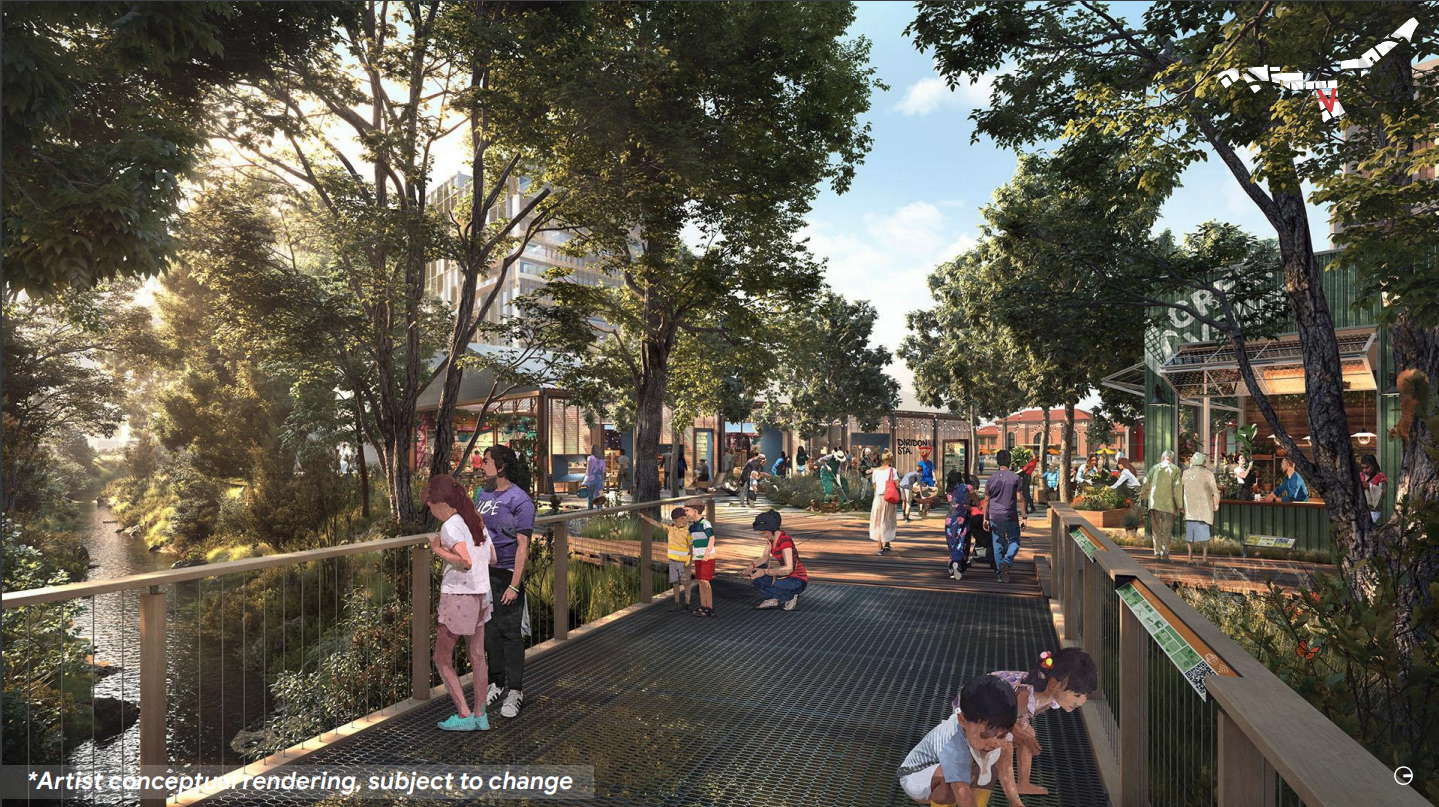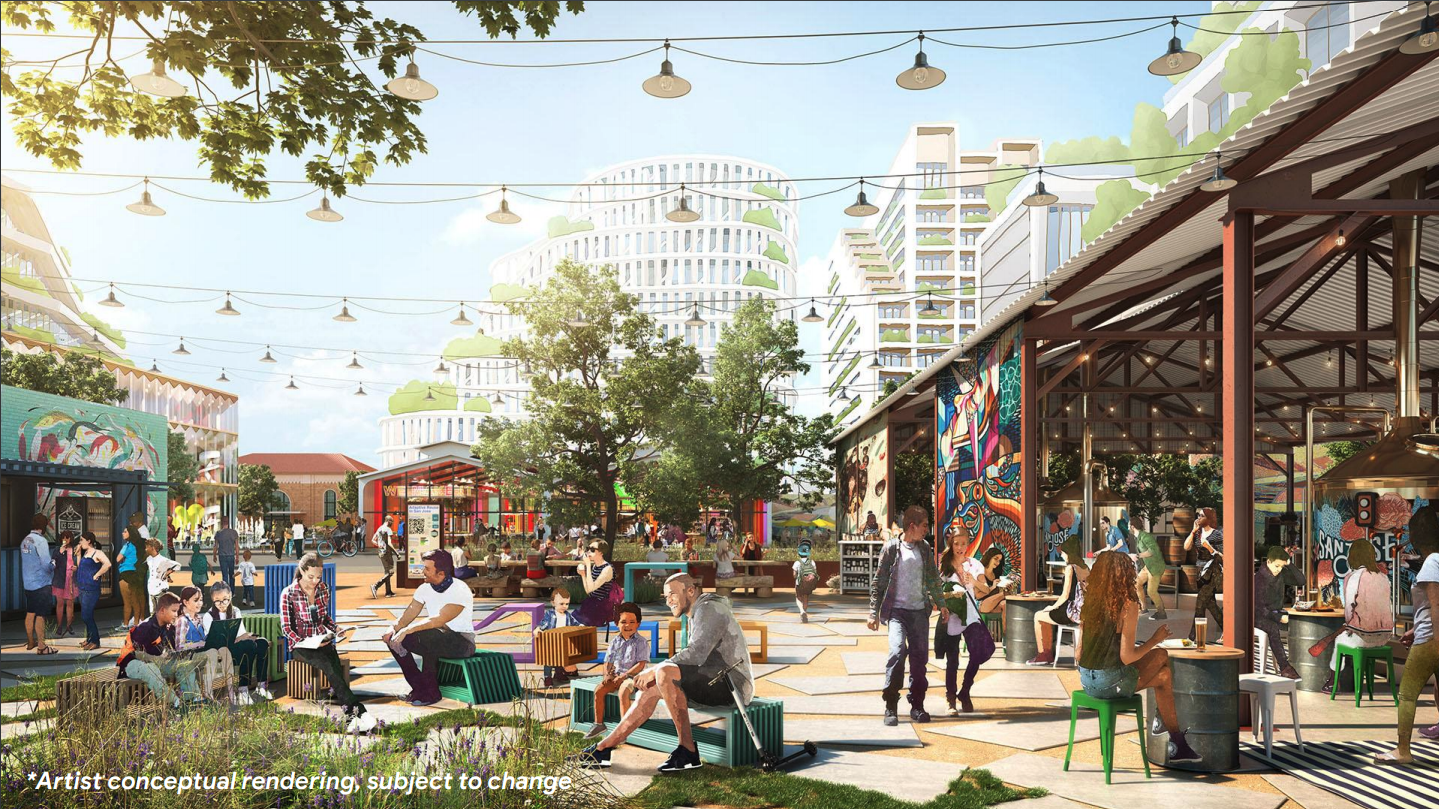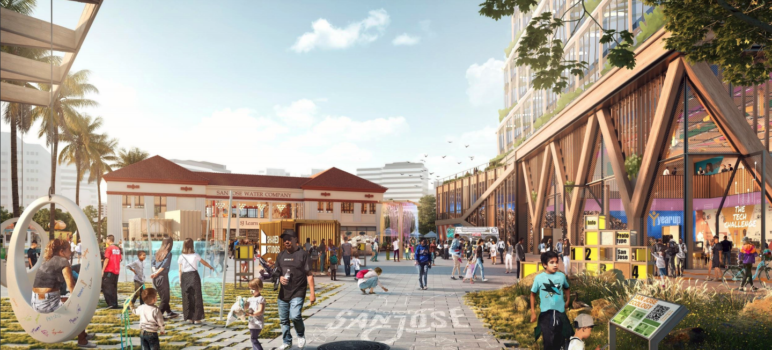Google and San Jose on Tuesday released a long-awaited proposed development agreement for a massive, mixed-use office campus that could rise around Diridon Station.
The agreement outlines the campus, called Downtown West, that Google wants to build in the 10th largest city in the country, but also the $200 million community benefits package and about $1 billion in other “features” it’s willing to offer up in exchange for the green light to construct the new campus.
The multinational tech giant aims to build about 6.5 million square feet of offices—though it is studying the impacts of building up to 7.3 million square feet of office space in its proposal.
Those offices, some of which could reach about 290 feet high, would be surrounded by 4,000 new homes, a spate of hotel rooms and 500,000 square feet of retail. All of that would sit within about 80 acres around the city’s transit hub that officials hope will eventually become one of the busiest transit stations on the West Coast where light rail, Caltrain, BART and high-speed rail would intersect, carrying 100,000 daily passengers.
“I’m proud that together with the City of San Jose, community, and local organizations we developed a project agreement with community benefits that focus on social equity and will help San José come back stronger from the pandemic’s impacts,” said Alexa Arena, Google’s San Jose development director. “Downtown West is a great example of a new way to approach development, where community is placed front and center.”
If completed, the mega-campus could employ around 25,000 people, according to Google. Those jobs, along with the tax dollars and the community benefit money the company has promised would offer a life-line to San Jose as it—and cities across the country—recover from the Covid-19 pandemic, Mayor Sam Liccardo said.
“This makes San Jose a national model for how we can rebuild equitably after this pandemic as cities throughout the country will be struggling mightily to address epic levels of unemployment and dislocation in their communities,” he told San Jose Inside. “San Jose is finding the path through this partnership and one that will pay benefits to our surrounding community for many years to come.”

A rendering of Google's Downtown West development along San Fernando. (Courtesy of Google)
Community Benefits
Part of that path includes about $200 million in community benefits promised by Google, including a $150 million nest egg called the Community Stabilization and Opportunity Pathways Fund. Google will contribute money to the new fund as it builds its project, contributing about $21.2 million for every 1 million square feet of office space completed, according to city data.
The project will likely take more than a decade to build, but some money would be approved up-front if Google gets the final approval on the development from the city’s elected officials, according to Google and city data.
As money comes into the fund, a third-party would manage it while a committee made up of residents would advise how the money should be spent, focusing on things like historically underrepresented communities, affordable housing, homelessness prevention or services and small business assistance.
The development agreement also comes with a promise to use local and diverse businesses to construct the project. Google also says it will gift the city nearly an acre of land ripe for affordable housing and build about 1,000 affordable homes in its own residential buildings.
“We are excited that Google’s announcement today includes a big commitment to housing in the Downtown West proposal,” Leslye Corsiglia, executive director for nonprofit Silicon Valley @ Home said. “As housing advocates, we hope this action serves as a catalyst for housing development in the … Diridon Station Area, which has the capacity to add up to 15,000 new homes.”
The tech giant has promised to host field trips, career days, and computer science workshops for students that come from underserved communities to promote STEM careers to students.
The development agreement is the result of years of negotiations, not only with the city, but also with community groups that emerged in recent years to tell Google what they wanted from a campus rising on the west end of the city’s downtown.
A key request was around parks, public art and retaining some buildings of historical significance. About 15 acres of parks, plazas and trails would weave throughout the 80-acre development, according to the development agreement. The Diridon Area Neighborhood Group [DANG], a community led collective is happy about that.
“DANG appreciates Google’s willingness to work with neighbors now,” said Bob Staedler, a spokesperson for the group. “They’ve laid the groundwork to create a long-term positive working relationship with all area stakeholders. DANG also appreciates Google’s contribution to new and existing parks and the programs that will benefit the broader community.”

A rendering of Google's Downtown West development. (Courtesy of Google)
A Long Way
It’s been nearly four years since San Jose officials gathered in a parking lot near the iconic Stephen’s Meats “dancing pig” sign to announce that the rumors were true: Google was considering a massive, mixed-use corporate campus in the city’s Diridon Station area—possibly up to 6 million square feet—and it could replace or reinvent the industrial-looking backdrop they stood before that day.
The project, if it came to fruition, would be a boon for San Jose, promised Mayor Sam Liccardo and other city council members standing side-by-side behind a portable podium. But first, they’d kick off negotiations with the tech giant to come up with a series of agreements about the potential development. Nothing was for-sure, city officials repeated.
Even so, the buzz, excitement and—for some wary residents—dread the June 6, 2017 announcement set off hasn’t let up, even in the middle of a global pandemic.
Since then, the project has grown steadily. Today, the office space alone that Google proposes would surpass the 6 million square feet the company reportedly envisioned for the overall development in 2017.
Now the question is whether it will be approved after almost four years of negotiations and an overhaul of the zoning guidelines and boundaries for the 262 acres around Diridon Station that will also be up for a vote this spring.
San Jose council members are tentatively expecting to vote on the development agreement May 25.
Before then, residents will have several chances to hear the details. The agreement will be presented on April 14 to the Station Area Advisory Group (SAAG), the committee tasked with recommending changes to the zoning and design guidelines around Diridon Station.
After that, an April 17 community meeting will precede an April 28 Planning Commission meeting to go over the details of the agreement.
Read the development agreement on the city of San Jose website.

A rendering of Google's Downtown West development along Autumn Street. (Courtesy of Google)


They should build a skate park for the underserved community of “Horseshoe” to replace the one the kids built that the water district destroyed yet the camps remain.
you will regret letting google wrap their tentacles around your neck and down your throat.
this will turn out only one way, bad for the poor, bad for latinos, bad for everyone that isnt 130 IQ and above
you are accelerating over the cliff and your consumption of propaganda
you had slim chance in the past, you have none now
Admiring Google for being active in community building and adding affordable as well as market-rate units to project. Hopefully, planners and landscapers will create an attractive community within the city that will be a boon to the Bay Area. Really wish Apple had considered their impact on and possible benefits to the community when designing their exclusive citadel nearby. Google is considering community benefit, integration, and transparency. Apple’s selfish, paranoid HQ is an epic failure in this regard. Google is building for maximum transit access. Apple built a drive-in campus with thousands of parking spaces and calls itself “green.”
What they said ^
It’s disappointing, but not surprising, to see zero mention of the impact this will have on the SAP Center, the San Jose Sharks, and their fans. The arena and team brought life to a desolate city in the early 90’s. It will be on Sam Liccardo and the San Jose city council members when the Sharks are forced to move because no one is considering the impact this project will have on the franchise. I get that Liccardo’s vision is for San Jose to be a west coast Manhattan where everyone walks, bikes, or takes public transit. And that’s fine for people who actually live downtown. Explain to me how fans and event-goers come and go from SAP Center when public transit isn’t an option. The last I looked, only an infinitesimal portion of season ticket holders can walk, bike, or use public transit. If Google or the city going to offset those loses?
Are you really sure that they are removing all the parking? If they build a few new parking garages, it will easily make up for the SAP Parking lot. It is so fun to just park anywhere downtown and walk the last half mile.
For those with disabilities, hopefully, they will retain plenty of parking right next to SAP Center.
Also, do not forget Uber/Lyft is much cheaper than parking if you live within 3-4 miles.
I feel like there are 1000s of options to get to SAP Center without having to park right next to the building, but pretty sure they will have plenty of onsite for those willing to pay for it.
It would be great if it happened. That said, I’m skeptical that a company that already has millions of square feet of empty office buildings and millions more already under construction will want to build even more empty office space. Only governments would do something like that.
Shawn,
Yes the plans call for a significant parking removal with no plans for new public parking options. You can find more info at https://futureofsapcenter.com/.
As for those with disabilities, the current plans look to remove the significant amount of disabled parking near the north entrance. If you live within 3-4 miles, uber/lyft/biking/public transit is an obvious option. However, there are many fans 10+ miles away that don’t have those options.
For some fans, yes, there are 1000s of options to get to SAP Center without having to park right next to the building. But for many others, by car is the only option. And it’s apparent that google and the city council doesn’t care. At every turn, the team and the venue has been treated as an afterthought despite all they’ve done for the city of San Jose.
I have already met several people in my neighborhood who never saw a Santa Rosa Plum or even an Apricot tree.
Maybe Google will plant an orchard as a “green roof?”
What’s happening with W. Hedding Street at Coleman Avenue?
Looks like “Affordable Housing” to me.
David S. Wall
Shawn,
Parking is being limited and charged, too, in accordance with typical current faddish behavior of activists, suited planners, and other socio-economic re-engineering advocates, applied to the rest of us.
For parking in the draft development agreement, see in particular Exhibit K, beginning at page 473 of the PDF file version:
https://www.sanjoseca.gov/Home/ShowDocument?id=70965
For parking in the draft amended Diridon Area Station Plan (San Jose), see in particular Section 4.5, Parking and Transportation Demand Management (TDM), beginning at page 124 of the PDF file version:
https://www.sanjoseca.gov/Home/ShowDocument?id=65897
The Sharks hockey team was put in a bad position as soon as there was a serious effort to pursue major employer development near that area, plus there are dreams of people not using cars to visit the area. and a diseased anti-car mentality with many of those dreamers. A number of us already expect it to relocate. As is already known, the team amounts to nothing to the Big Players versus Google (one of the Big Players, itself).
One question is what the county might do, but I suspect the inner circle has its plans already.
A. J., here is #1 of 2. (I submitted a remark with both parts but it was held up for moderation because it has two links in it. Time’s up, already. Next time be faster.)
For parking in the draft development agreement, see in particular Exhibit K, beginning at page 473 of the PDF file version:
https://www.sanjoseca.gov/Home/ShowDocument?id=70965
A. J., here is #2 of 2.
For parking in the revised draft Diridon Station Area Plan, see in particular Section 4.5, “Parking and Transportation Demand Management (TDM),” beginning at page 124 of the PDF file version:
https://www.sanjoseca.gov/Home/ShowDocument?id=65897
The above picture is not accurate. They forgot the tents and shopping carts that will be on the sidewalk. Remember don’t leave the homeless out.
When I look at the artist renderings of this future Google downtown, the only thing that’s missing are the tons of homeless, bum and junkies. No kids are playing in downtown parks as the artist showed because of the horrific policies that allow homeless encampments everywhere.
Define ‘AFFORDABLE’ in real terms — (no one ever really does) This is a ‘generic term’ used by developers and systematic is semantic wording to make things ‘appear’ ok. Its never really defines the reality of STILL overpriced and the continuing escalating cost beyond reach of decent housing cost. It is just a ‘cover word’ to make things sound good in terms of not really changing anything—-nothing all ALL. I have worked over the years in planning commissions in my local community and see how this really ‘works’ —
In reality, MANNY, “affordable” has been defined for ages. “No one ever really does” state the definition ordinarily because people are assumed to know, and it matches the general impression people have. Some scoff and equivocate, say something is affordable if someone can buy or rent it. That’s not the definition or general view of people, of course, nor the informal or formal definition used.
Affordability is defined for the whole community, and is gauged by how much home prices or rents are with respect to incomes. With homes to buy it’s the multiple of median home prices to median incomes that is the basic measure for any area. (This can be inverted to show a fraction or percentage of the price, or used to obtain the minimum income needed to buy a home based on its price.) More than about three times income is too high. The old-fashioned measure of 2 1/2 times (or income forty per cent of the price) remains sound, and thrifty people would have striven for less if possible. The old measure or less has been unrealistic to effectively impossible for many places for a long time, and three times or near it (income thirty percent to one-third of the price) has long become a new metro area standard, a reduction in standard of living by consigning more income to housing. In a number of places the “multiples” are much higher, of course, for prices relative to incomes, including the Bay Area.
With rents, it’s percentage of one’s income. More than 30 per cent is too high. Rents are a subject that includes a related concept, “rent burden” or “housing burden” in which rents can exceed 30 per cent or 50 per cent, typically to qualify as “burdened” and “excessively burdened” or similar terms. You’re probably familiar with those terms with housing agencies, social services, poverty research.
Housing is not built toward the median, but often aimed upscale with prices or rents because that’s what pays best. “They” are going after dollars, not people.
In real terms, “affordability” is in terms of sales price or rent to median incomes.
(Incomes for portions of the population can be investigated, but that’s separate.)
Parking is a privilege, not a right.